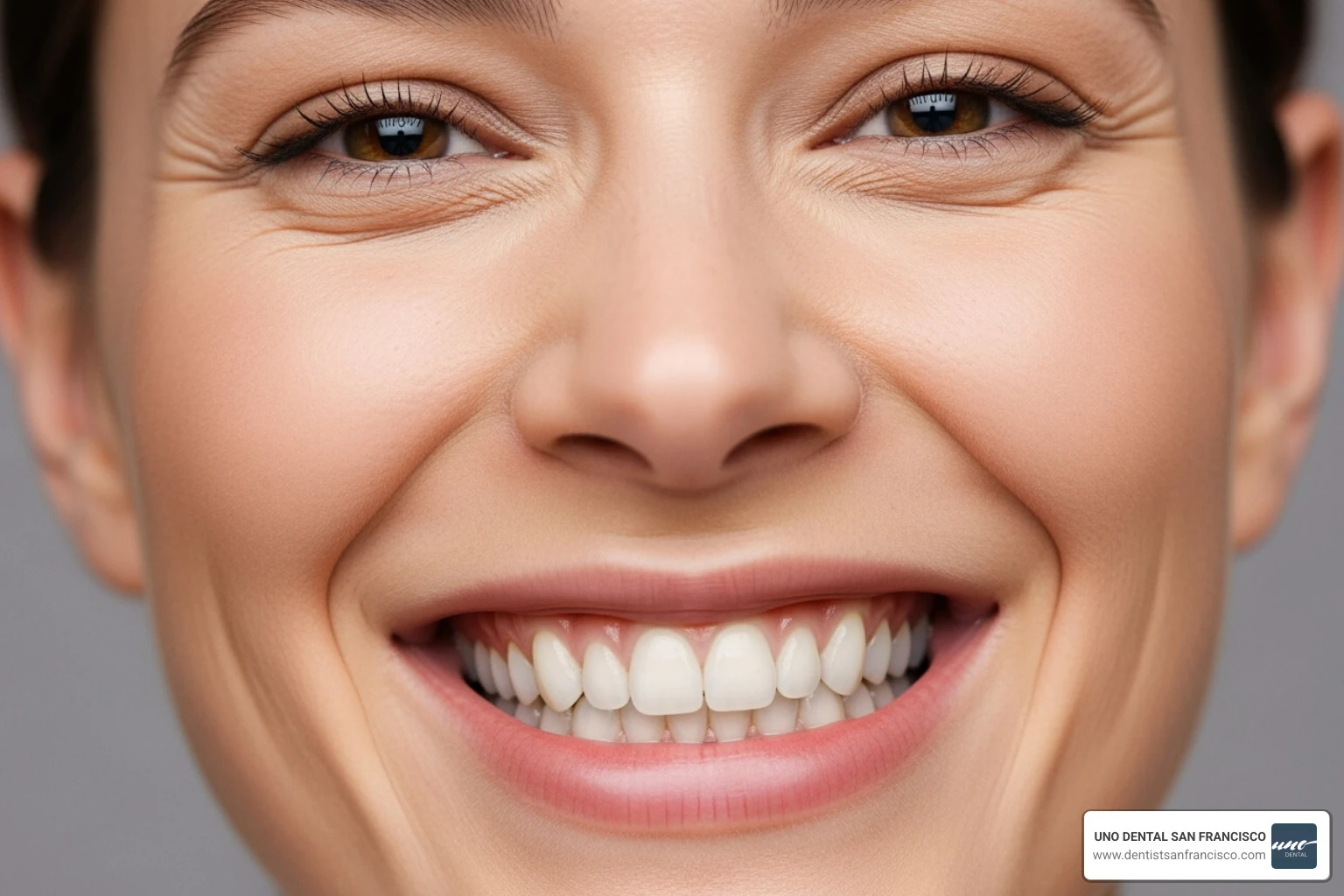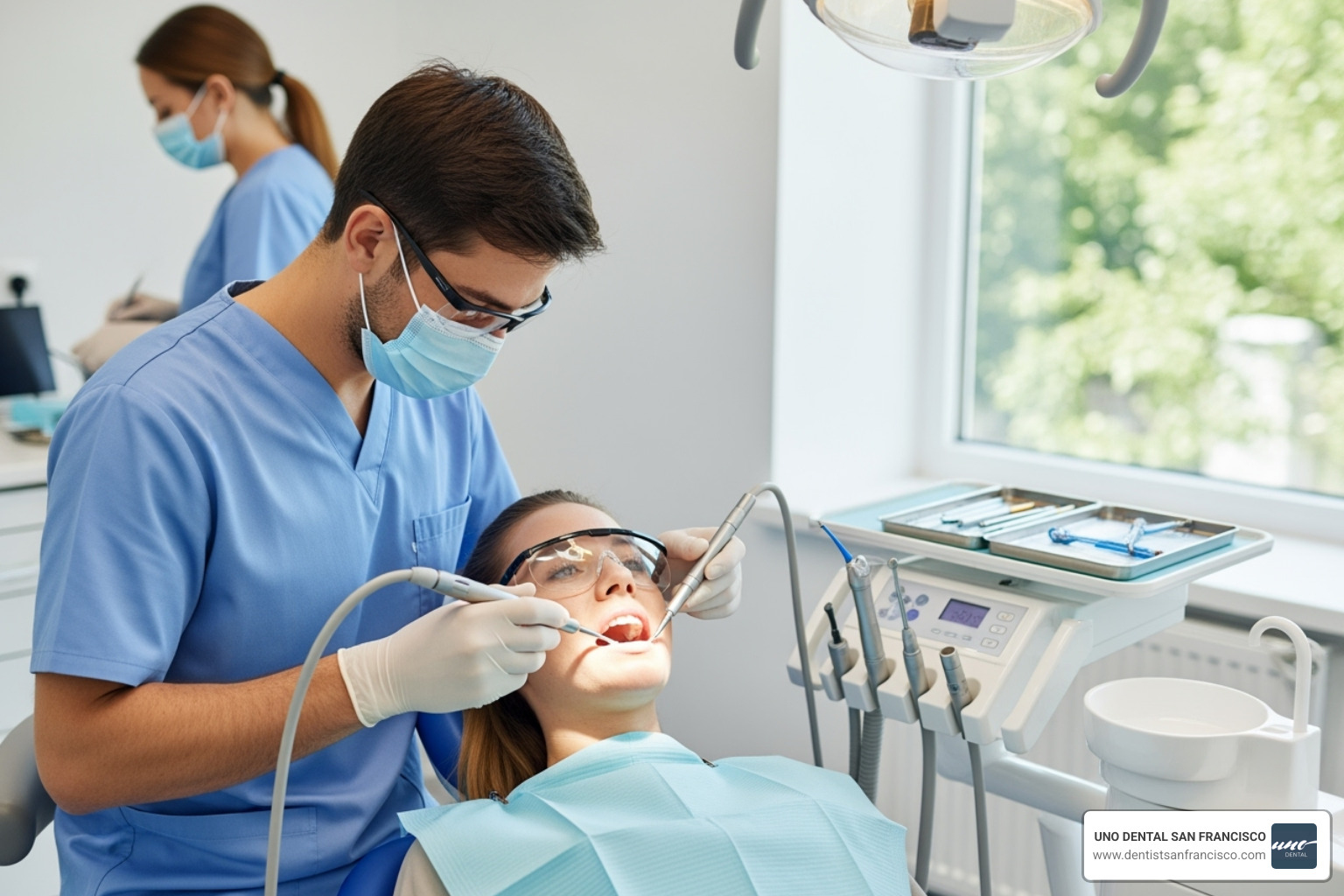
Why a Bright Smile Requires More Than Just Whitening
Medically reviewed by Dr. Mohammad Aghiad Kandar, DDS — UNO DENTAL SAN FRANCISCO
To maintain white teeth after whitening, you need to:
- Brush twice daily with a soft-bristled toothbrush and floss once daily
- Limit staining beverages like coffee, tea, and red wine (or use a straw)
- Rinse with water immediately after consuming staining foods or drinks
- Wait 30-60 minutes before brushing after acidic foods to protect enamel
- Quit tobacco use completely to prevent nicotine and tar stains
- Schedule professional cleanings every six months to remove stubborn surface stains
- Use whitening toothpaste 1-2 times per week for maintenance
- Consider touch-up treatments as recommended by your dentist
Americans spend over $1 billion annually on teeth whitening, driven by a demand for perfect smiles. But what most people don't realize is that getting your teeth white is just the beginning.
Think of it like washing your car—you wouldn't drive through mud right after. The same principle applies to your teeth. After investing in whitening, a maintenance plan is crucial to protect your results.
It's not about perfection, but about understanding what dulls your smile and taking simple steps to keep it looking its best. Whether you've had professional whitening or are preserving naturally white teeth, the strategies are the same.
The good news is that maintenance doesn't require extreme changes, just awareness and consistency.
I'm Dr. Mohammad Aghiad Kandar at UNO DENTAL SAN FRANCISCO. With 15 years of experience in cosmetic and restorative dentistry, I've helped hundreds of patients achieve and maintain white teeth. The most successful patients are those who understand why teeth stain and how to prevent it.
Understanding Tooth Discoloration: The "Why" Behind the Fade
To effectively maintain white teeth, you must understand what causes discoloration—a combination of factors that develop over time. Think of your teeth as a canvas: some stains are on the surface, while others are deeper. This difference determines your strategy.
Extrinsic stains are surface-level troublemakers affecting your enamel, the hard outer shell of your teeth. They're caused by daily habits and what you consume. Coffee, red wine, and dark berries contain chromogens (pigmented molecules) that cling to enamel, aided by tannins—plant-based compounds that help colors stick.
Tobacco is particularly brutal for surface staining. Nicotine and tar create stubborn yellow-brown stains that worsen over time.
Intrinsic stains go deeper, affecting the dentin—the softer, yellowish layer beneath your enamel. These internal stains are trickier and can result from medications like tetracycline, tooth trauma, or excessive fluoride exposure during childhood. Genetics can also play a role in naturally darker dentin.
What surprises most people is age-related discoloration. As you age, your enamel thins from wear, while the dentin beneath it darkens. The result is more yellow showing through a thinner white layer.
This leads to a major factor in discoloration: enamel erosion. When enamel wears away, it exposes more yellow dentin. Acidic drinks like soda and citrus juices soften enamel, making it more vulnerable. Even brushing too hard can wear it down. Research shows enamel erosion is a key factor in how quickly teeth lose brightness.
Understanding these causes is your roadmap to building an effective defense strategy.
Everyday Strategies to Maintain White Teeth
Maintaining a bright smile isn't complicated. The most effective strategies are simple daily habits that build a protective shield around your smile, one thoughtful choice at a time.
The Foundation: A Flawless Oral Hygiene Routine
A solid oral hygiene routine is non-negotiable for keeping teeth white. While you've heard it before, many people miss crucial details.
Brushing twice daily for two minutes with a soft-bristled toothbrush is your first line of defense. Following ADA recommendations for brushing is key, as plaque—the sticky film on your teeth—is a magnet for stains. Removing plaque removes the stains' landing pad.
Daily flossing is equally critical. Your toothbrush can't reach between teeth, where trapped food and plaque create pockets for stains to hide and darken.
Surprisingly, brushing immediately after acidic foods or drinks (like citrus, soda, or tomato sauce) can harm your teeth. Acid temporarily softens enamel, and brushing can scrub it away. Instead, wait 30 to 60 minutes for saliva to neutralize the acids. In the meantime, rinse with water.
Brushing too hard also damages enamel and causes gum recession, exposing the yellowish dentin. Use gentle, circular motions—your toothbrush isn't a scrub brush.
For comprehensive guidance on protecting your smile, check out more info about how to Whiten Teeth Safely.
The "White Teeth Diet": What to Eat and What to Avoid
Your diet significantly impacts tooth color. Understanding which foods stain and which protect helps you make smarter choices.
The worst offenders contain chromogens (pigments) and tannins (compounds that help pigments stick). Coffee, tea, and red wine top this list, as their compounds bind to enamel. If you're a coffee lover, our guide on Teeth Whitening for Coffee Stains offers practical strategies.
Dark berries, dark sauces like soy sauce and balsamic vinegar, and even dark chocolate can also leave their mark. Acidic foods like citrus and fruit juices erode enamel, making teeth more porous and vulnerable to staining, as confirmed by research showing enamel erosion is a key factor in discoloration. Sugary foods feed plaque-causing bacteria, giving stains more surface area to cling to.
On the other hand, some foods help maintain white teeth. Crunchy fruits and vegetables like apples and carrots act like natural toothbrushes, while calcium-rich foods like milk and cheese strengthen enamel. Water is your best friend, as it dilutes acids and washes away food particles without staining.
After a whitening treatment, the first 48 hours are crucial. Your enamel is more porous, so sticking to a "white diet" of light-colored foods is essential. For a detailed list, see our Teeth Whitening Aftercare Diet guide.
Smart Habits for a Stain-Free Smile
Beyond diet and brushing, a few strategic habits can extend your whitening results.
Using a straw for dark beverages is a game-changer, directing liquids past your front teeth to reduce enamel contact.
Rinsing with water after meals is another easy win. Swishing with water after consuming staining or acidic items washes away pigments and acids before they can settle.
To truly maintain white teeth, quitting tobacco is non-negotiable. The nicotine and tar in tobacco cause severe, deep-set stains that are extremely difficult to remove. Beyond aesthetics, tobacco use increases your risk of gum disease and oral cancer. Quitting doesn't just brighten your smile—it can save your life.
These strategies are about awareness and consistency. Small, daily adjustments create a foundation for lasting whiteness.
Advanced Maintenance: At-Home and Professional Touch-Ups
While daily habits are essential, at-home products and professional treatments can provide extra help to maintain white teeth.
How to maintain white teeth with At-Home Products
The market is flooded with at-home whitening products, but it's important to choose wisely and understand how they work.
- Whitening Toothpastes: These use mild abrasives (like baking soda) to polish surface stains or chemical agents (like hydrogen peroxide) to break them down. While they don't change your natural tooth color, they are effective for maintenance. Studies show that toothpastes with more hydrogen peroxide can be more effective. We recommend using them 1-2 times a week after consulting with us.
- Custom-Fit Trays vs. Over-the-Counter (OTC) Options: While OTC trays are available, custom-fit trays from your dentist are safer and more effective. One-size-fits-all OTC options can lead to uneven results and gum irritation from leaking gel. Custom trays, made from impressions of your teeth, ensure the gel is evenly distributed. This maximizes effectiveness and allows us to prescribe stronger, professional-grade gels that are safe under our guidance. We offer Custom-Fit Teeth Whitening Trays and a comprehensive At Home Dental Whitening Guide.
The Role of Natural Remedies
Many natural remedies are touted for teeth-whitening, but approach them with caution and realistic expectations.
- Oil Pulling: Swishing coconut oil may reduce plaque and gingivitis according to limited evidence, but its whitening effects are unproven. It's generally considered safe.
- Baking Soda: As a mild abrasive, it can help remove surface stains. Studies show toothpastes with baking soda are effective at reducing plaque and gum inflammation.
- Hydrogen Peroxide: A diluted solution can be used as a mouthwash, but overuse can cause irritation.
- Fruit Peels and Acids: Claims about fruit peels or acids (from strawberries, pineapple) whitening teeth lack strong scientific evidence and can be acidic, potentially softening enamel.
- Activated Charcoal: Despite its popularity, research suggests it's likely ineffective and can be too abrasive, damaging enamel.
Our advice is to stick to proven, safe methods. Prioritize remedies that won't harm your enamel. If you're unsure, we're here to offer guidance.
Partnering with Your Dentist for Lasting Luster
For effective and safe long-term maintenance, partnering with your dental professional is invaluable.
- Professional Cleanings: Crucial for maintaining whiteness, professional cleanings remove plaque, tartar, and stubborn surface stains that home care can't. We recommend cleanings at least twice a year to monitor your oral health and keep your smile bright.
- Touch-Up Treatments: Teeth can re-stain over time. We can recommend periodic at-home touch-ups with custom trays or in-office booster treatments to refresh your results. The optimal regimen is often an initial in-office treatment followed by at-home touch-ups, which we will tailor to your needs.
- Dentist Consultation: Consulting with us is paramount before and after any whitening procedure. We assess the cause of your discoloration, determine if you're a good candidate, and recommend the safest, most effective plan. For advanced whitening, we offer highly effective in-office treatments.
Frequently Asked Questions about Keeping Teeth White
In my practice at UNO DENTAL SAN FRANCISCO, I often hear the same questions about maintaining a bright smile. Here are the most common ones.
What are the risks of teeth whitening and how can I avoid them?
Teeth whitening is remarkably safe when done correctly, but potential side effects, though usually mild and temporary, can occur.
The most common are tooth sensitivity and gum irritation. More serious risks like enamel damage or effects on dental restorations typically stem from misuse or overuse of products, as noted in this scientific review on whitening safety.
How do you protect yourself? Professional supervision is your best defense. We evaluate your oral health, identify risks, and recommend the safest approach. Following instructions on application times and concentrations is crucial. Custom trays from a dentist are superior to OTC options as they prevent gel from contacting your gums. If you experience sensitivity, a desensitizing toothpaste can help. Most importantly, resist the urge to overdo it.
At UNO DENTAL, your health comes first. A gradual, monitored approach often yields the best and safest results.
How long do teeth whitening results typically last?
Whitening results vary, but most patients see them last from six months to three years.
The duration depends on several factors. Lifestyle choices are the biggest: frequent consumption of coffee, wine, or tea, along with tobacco use, will cause teeth to re-stain more quickly. A consistent oral hygiene routine and the type of whitening treatment also play a huge role. Professional treatments paired with at-home touch-ups typically last longer.
The key to extending your results is combining diligent home care, mindful dietary choices, and periodic touch-ups. We'll help you develop a personalized maintenance schedule.
Is it safe to maintain white teeth after getting braces?
Yes, but timing is everything. We advise waiting a few weeks to a month or two after your braces are removed before starting any whitening treatment.
Why the wait? Your enamel needs time to remineralize after having brackets bonded to it. This recovery period strengthens teeth, reduces sensitivity, and ensures even whitening results. It also allows your gums to heal from any inflammation caused by the braces.
Once your teeth and gums have recovered, you can safely proceed with whitening. All the standard maintenance strategies discussed here will help you maintain white teeth long after your orthodontic journey. For more details, visit our page on Teeth Whitening After Braces.
At UNO DENTAL SAN FRANCISCO, we love helping patients improve their newly straightened smiles with professional whitening for a remarkable, lasting change.
Conclusion: Your Long-Term Strategy for a Radiant Smile
You've invested in a gleaming smile. Now you know that keeping it bright is about consistency and awareness, not perfection. Maintaining a white smile is a marathon, not a sprint, but you don't have to do it alone or make it complicated.
We've covered three essential pillars to help you maintain white teeth:
- Daily Oral Hygiene: Your foundation. Brushing twice daily with a soft-bristled toothbrush and flossing once a day removes the plaque and food particles that dull your smile.
- Dietary Choices and Habits: Being mindful—using a straw, rinsing with water after staining foods, and waiting to brush after acidic drinks—offers significant protection. Quitting tobacco is the most impactful step for your smile and overall health.
- Professional Dental Care: This ties it all together. Regular six-month cleanings remove stubborn stains and allow us to provide personalized advice on touch-up treatments.
At UNO DENTAL SAN FRANCISCO, we help patients not just achieve beautiful smiles, but keep them. Our high-tech, holistic approach focuses on individualized treatment plans that fit your life, promoting long-term oral health and confidence. We know every person's teeth, lifestyle, and goals are different.
Whether you've just completed a whitening treatment or are planning one, we're here to support you. We even offer free virtual smile consultations, so you can start your journey from home.
Your smile is worth protecting. With the right strategy—combining what you do at home with what we do together—you can enjoy a bright, confident smile for years to come.



